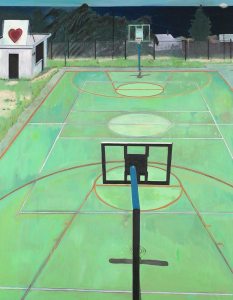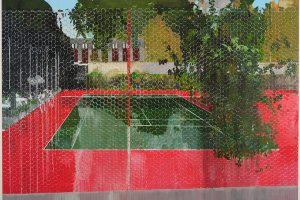While Edinburgh’s National Gallery of Scotland recently held their Peter Doig exhibition ‘No Foreign Lands’, Birmingham’s Ikon Gallery displayed an extensive selection of Hurvin Anderson’s work in ‘Reporting Back’. The retrospectives overlapped temporally, but also formally and thematically.
Each was a homecoming of sorts, and the painters’ biographies have a certain symmetry. Doig was born in Edinburgh and spent five years in Trinidad as a child before his family relocated to Canada. He studied in London during the 1980s, and settled in Trinidad after a residency in 2003, alongside other UK artists such as Chris Ofili.
Anderson was born in Birmingham where his Jamaican parents settled after emigrating, and studied in London during the 1990s: his work reflects on moving between the geographies of Birmingham, Jamaica and Trinidad. Despite these shared locations, it is however the experience of displacement that links their work.

The Heart of Old San Juan (1999), Peter Doig Private collection
In 2007 Doig reflected: ‘for the most part the paintings I made in the last few years in Trinidad were all based, initially, on subjects that came from outside Trinidad. Maybe I was painting Trinidad by proxy.’ Similarly, in the foreword to ‘Reporting Back’, Jonathan Watkins notes, ‘the scenes Anderson depicts are sites of leisure where the mind is usually free to wander. He talks of being in one place “but actually thinking about another”, not as a problem necessarily but as a fact of his life’.
This process of occupying one location while invoking or imagining another also informs Anderson and Doig’s self-conscious citations from painterly tradition, and their foregrounding of photography as a source material. Interests in movement, dislocation, and uncanny hauntings, thread through their paintings, linking their work to wider debates about the ambivalent status of the local within globalisation.
The two galleries’ curatorial strategies, however, underlined subtle but significant distinctions between Doig and Anderson. Although the National Gallery of Scotland’s title ‘No Foreign Lands’ implied that everywhere is ‘home’, the exhibition slid inexorably into exoticism, framing the work Doig has completed since moving to Trinidad as out-of-time meditations on dream-like flora and fauna.
His Boat Paintings, we were told, show Doig ‘at home in the exotic, tropical setting of Trinidad and not afraid to tackle subjects that Gauguin had made famous a hundred years before.’ Maybe he should be afraid. ‘At home in the exotic’ is something of an oxymoron: ‘the exotic’, here, was freighted with associations of foreignness and otherness. You started to suspect Graham Greene and Joseph Conrad characters lurking behind Doig’s ravishing colour fields. By contrast, Ikon’s title ‘Reporting Back’ vibrated with the locational uncertainty that Anderson’s paintings tease out rather than sublimate.

Country Club Series: Chicken Wire (2008), Hurvin Anderson. Courtesy Gordon Watson
Then there are the paintings: compare Doig’s The Heart of Old San Juan (1999) with Anderson’s Country Club Series: Chicken Wire (2006). Doig depicts an abandoned basketball court, its lime-green surface bisected by hot pink lines. At one edge sits a small hut, bearing a sign emblazoned with the eponymous heart. The work has tension, but it’s deflated slightly by that saccharine detail.
Anderson’s Country Club Series: Chicken Wire comparably shows an empty tennis court, screened-off by a delicate scrim of hexagonal wire. Where Doig presents the romanticised percolation of landscape through nostalgic memory and mediatised clichés, Anderson plays with deceptively attractive, almost imperceptible barriers to provoke reflection on the pastoral’s history of exclusions and prohibitions.
‘No Foreign Lands’, meanwhile, presented Doig as evidence against the ‘death of painting’. While the ‘death of painting’ narrative feels horribly tired, the move to counter it is in danger of seeming just as weary. Artists like Anderson, Dana Schutz (currently at the Hepworth Wakefield), Tomma Abts (appearing alongside Gillian Carnegie, Simon Ling, Lucy McKenzie and Catherine Story in Tate’s ‘Painting Now’), Lynette Yiadom-Boakye and Fiona Rae consistently produce paintings that combine the figurative and abstract in complex meditations on identity, representation, place and post-modernity, drawing on references from Constable to De Kooning. It’s less a case of using paint to explore the binary of home/not at home, or to make a point about medium specificity, but to reflect on the hybrid identities that emerge from multiple influences, sources and images.
‘Peter Doig: No Foreign Lands’ was at the Scottish National Gallery, Edinburgh, from 3 August−3 November 2013.
‘Hurvin Anderson: Reporting Back’ was at Ikon Gallery, Birmingham, from 25 September–10 November 2013. A solo exhibition of the artist’s recent work was open at Thomas Dane Gallery, London, from 15 October–16 November 2013.

Exotic Dangers
Country Club: Chicken Wire (2008), Hurvin Anderson. Image: courtesy Michael Werner Gallery
Share
While Edinburgh’s National Gallery of Scotland recently held their Peter Doig exhibition ‘No Foreign Lands’, Birmingham’s Ikon Gallery displayed an extensive selection of Hurvin Anderson’s work in ‘Reporting Back’. The retrospectives overlapped temporally, but also formally and thematically.
Each was a homecoming of sorts, and the painters’ biographies have a certain symmetry. Doig was born in Edinburgh and spent five years in Trinidad as a child before his family relocated to Canada. He studied in London during the 1980s, and settled in Trinidad after a residency in 2003, alongside other UK artists such as Chris Ofili.
Anderson was born in Birmingham where his Jamaican parents settled after emigrating, and studied in London during the 1990s: his work reflects on moving between the geographies of Birmingham, Jamaica and Trinidad. Despite these shared locations, it is however the experience of displacement that links their work.
The Heart of Old San Juan (1999), Peter Doig Private collection
In 2007 Doig reflected: ‘for the most part the paintings I made in the last few years in Trinidad were all based, initially, on subjects that came from outside Trinidad. Maybe I was painting Trinidad by proxy.’ Similarly, in the foreword to ‘Reporting Back’, Jonathan Watkins notes, ‘the scenes Anderson depicts are sites of leisure where the mind is usually free to wander. He talks of being in one place “but actually thinking about another”, not as a problem necessarily but as a fact of his life’.
This process of occupying one location while invoking or imagining another also informs Anderson and Doig’s self-conscious citations from painterly tradition, and their foregrounding of photography as a source material. Interests in movement, dislocation, and uncanny hauntings, thread through their paintings, linking their work to wider debates about the ambivalent status of the local within globalisation.
The two galleries’ curatorial strategies, however, underlined subtle but significant distinctions between Doig and Anderson. Although the National Gallery of Scotland’s title ‘No Foreign Lands’ implied that everywhere is ‘home’, the exhibition slid inexorably into exoticism, framing the work Doig has completed since moving to Trinidad as out-of-time meditations on dream-like flora and fauna.
His Boat Paintings, we were told, show Doig ‘at home in the exotic, tropical setting of Trinidad and not afraid to tackle subjects that Gauguin had made famous a hundred years before.’ Maybe he should be afraid. ‘At home in the exotic’ is something of an oxymoron: ‘the exotic’, here, was freighted with associations of foreignness and otherness. You started to suspect Graham Greene and Joseph Conrad characters lurking behind Doig’s ravishing colour fields. By contrast, Ikon’s title ‘Reporting Back’ vibrated with the locational uncertainty that Anderson’s paintings tease out rather than sublimate.
Country Club Series: Chicken Wire (2008), Hurvin Anderson. Courtesy Gordon Watson
Then there are the paintings: compare Doig’s The Heart of Old San Juan (1999) with Anderson’s Country Club Series: Chicken Wire (2006). Doig depicts an abandoned basketball court, its lime-green surface bisected by hot pink lines. At one edge sits a small hut, bearing a sign emblazoned with the eponymous heart. The work has tension, but it’s deflated slightly by that saccharine detail.
Anderson’s Country Club Series: Chicken Wire comparably shows an empty tennis court, screened-off by a delicate scrim of hexagonal wire. Where Doig presents the romanticised percolation of landscape through nostalgic memory and mediatised clichés, Anderson plays with deceptively attractive, almost imperceptible barriers to provoke reflection on the pastoral’s history of exclusions and prohibitions.
‘No Foreign Lands’, meanwhile, presented Doig as evidence against the ‘death of painting’. While the ‘death of painting’ narrative feels horribly tired, the move to counter it is in danger of seeming just as weary. Artists like Anderson, Dana Schutz (currently at the Hepworth Wakefield), Tomma Abts (appearing alongside Gillian Carnegie, Simon Ling, Lucy McKenzie and Catherine Story in Tate’s ‘Painting Now’), Lynette Yiadom-Boakye and Fiona Rae consistently produce paintings that combine the figurative and abstract in complex meditations on identity, representation, place and post-modernity, drawing on references from Constable to De Kooning. It’s less a case of using paint to explore the binary of home/not at home, or to make a point about medium specificity, but to reflect on the hybrid identities that emerge from multiple influences, sources and images.
‘Peter Doig: No Foreign Lands’ was at the Scottish National Gallery, Edinburgh, from 3 August−3 November 2013.
‘Hurvin Anderson: Reporting Back’ was at Ikon Gallery, Birmingham, from 25 September–10 November 2013. A solo exhibition of the artist’s recent work was open at Thomas Dane Gallery, London, from 15 October–16 November 2013.
Unlimited access from just $16 every 3 months
Subscribe to get unlimited and exclusive access to the top art stories, interviews and exhibition reviews.
Share
Recommended for you
Apollo Advent Calendar: Day 6
Only 20–30 Netherlandish paintings are known to survive from the early 1400s. The Museum Boijmans Van Beuningen recently acquired one
National Treasure?
The Reith Lectures may have confirmed him as a national treasure, but Grayson Perry retains a sharp realist edge
Apollo Advent Calendar: Day 17
‘I am told I got it to look better than anything I have yet done,’ said Constable of this iconic painting of Salisbury Cathedral